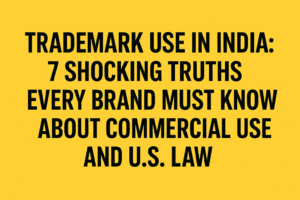Trademark Use in India: 7 Shocking Truths Every Brand Must Know About Commercial Use and U.S. Law
Trademark rights in India hinge on genuine commercial use, not just registration. While the Trade Marks Act, 1999 allows filings based on intent-to-use, marks risk cancellation if unused for five years and three months. Courts emphasize bona fide engagement, rejecting token use—actual sales, advertising, or digital presence must demonstrate market activity. Non-traditional marks, like colors, face stricter scrutiny, requiring proof of acquired distinctiveness (Colgate v. Anchor).
Comparatively, U.S. law demands similar evidence, as seen in recent rulings denying color trademarks lacking consumer recognition. For businesses, documenting use—invoices, promotions, licenses—is critical for enforcement. Ultimately, both jurisdictions prioritize real market presence over mere registration, reinforcing that trademark rights are earned, not just claimed.

Trademark Use in India: 7 Shocking Truths Every Brand Must Know About Commercial Use and U.S. Law
Trademark rights are fundamentally rooted in commercial use—not just registration. A recent U.S. Federal Circuit ruling denying trademark protection for a dark green color on medical gloves (due to lack of acquired distinctiveness) has reignited discussions on how jurisdictions assess “use” for non-traditional marks like colors, sounds, and shapes.
India, like the U.S., permits registration of non-conventional trademarks but imposes strict evidentiary requirements to prove their distinctiveness. This article examines India’s legal stance on trademark “use,” compares it with U.S. principles, and offers practical insights for businesses navigating both systems.
- The Statutory Framework: Use vs. Intent-to-Use in India
Under India’s Trade Marks Act, 1999, “use” is not mandatory for filing a trademark application—applicants can register marks based on:
- Prior Use (Section 18(1)): For marks already in commerce.
- Proposed Use (Section 18(1)): For marks not yet used but intended for future commercial activity.
However, Section 47 allows cancellation if a registered mark remains unused for five years and three months post-registration. This prevents “trademark squatting” and ensures only actively used marks retain protection.
Key Judicial Interpretations
- Hardie Trading Ltd. v. Addisons Paint & Chemicals Ltd. (2003): Use by licensees or distributors qualifies as “use” under Indian law.
- Ramdev Food Products v. Arvindbhai Patel (2006): Token use is insufficient—bona fide commercial engagement is required.
- Tata Sia Airlines v. Union of India (2023): Internal documents alone don’t constitute “use”; public-facing commercial activity is necessary.
- What Constitutes “Use” in India?
Indian courts recognize both actual and demonstrative use, provided it reflects genuine trade engagement:
- Sales & Distribution: Invoices, purchase orders, and retail presence.
- Advertising & Promotion: Campaigns targeting Indian consumers.
- Digital Use: E-commerce listings, social media, and domain activity.
Exceptions:
- Mere internal R&D or prototypes don’t qualify.
- Use must be in India—foreign reputation alone doesn’t suffice (unlike passing-off claims).
- Non-Traditional Marks: The High Bar for Color Trademarks
While India allows registration of color marks (under Section 2(1)(m)), courts demand exceptional proof of acquired distinctiveness:
- Colgate Palmolive v. Anchor Health (2003): Denied exclusive rights over red-white toothpaste packaging, ruling colors aren’t inherently distinctive.
- Trade Marks Manual (2018): Single colors face higher scrutiny; long-term exclusive use must be proven.
Comparison with U.S. Law
The recent U.S. Federal Circuit ruling on green medical gloves mirrors India’s stance:
- Colors must function as source identifiers.
- Survey evidence, consumer recognition, and exclusivity are critical.
- Practical Implications for Businesses
For Indian Trademark Owners:
✔ Document Use: Maintain invoices, ads, and licensing agreements.
✔ Avoid “Warehousing”: File only if genuine commercial intent exists.
✔ Non-Traditional Marks: Expect tougher scrutiny—build evidence of consumer association.
For U.S. Expansion:
- U.S. law requires actual use in commerce (via the Lanham Act).
- India’s “proposed use” system is more lenient, but enforcement depends on proving real use.
Conclusion: Aligning Indian Practice with Global Standards
While India’s trademark system accommodates intent-to-use filings, sustained commercial use remains pivotal for enforcement and defense. The parallels between Indian and U.S. jurisprudence—especially for non-traditional marks—highlight a global trend: trademark rights are earned through market presence, not just registration.
You must be logged in to post a comment.